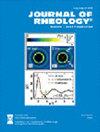从复原流变学的角度重新审视考克斯-梅尔兹法则
IF 3
2区 工程技术
Q2 MECHANICS
引用次数: 0
摘要
经验法则在工业和实验环境中发挥着至关重要的作用,可有效测定材料的流变特性,从而节省时间和资源。Cox-Merz 规则就是一个例子,它将稳定剪切粘度等同于振荡试验中获得的复合粘度的大小。这一经验法则提供了稳定剪切粘度的获取途径,可用于加工条件,而不会产生与高剪切速率实验相关的不稳定性。不过,Cox-Merz 法则是经验性的,在某些情况下有效,在另一些情况下则失效。不同材料函数之间的内在联系仍然是现象学上的,由于缺乏对流变物理学的全面了解,在解释材料响应时仍然存在模糊性。在这项工作中,我们利用恢复流变学重新审视了 Cox-Merz 规则,该规则将应变分解为可恢复和不可恢复两部分。从恢复流变学的角度来看,我们可以清楚地看到,稳定剪切粘度纯粹来自不可恢复的应变获取,而复合粘度则是由可恢复和不可恢复成分共同决定的。考虑到恢复测试,我们阐明了 Cox-Merz 法则仅在有限条件下有效的原因,并提出了一种可进行普遍比较的方法。这项工作进一步突出了恢复流变学的意义,表明了如何通过将材料响应分解为可恢复和不可恢复成分来获得清晰的流变物理指标,从而超越现象学方法。本文章由计算机程序翻译,如有差异,请以英文原文为准。
A reexamination of the Cox–Merz rule through the lens of recovery rheology
Empirical rules play a crucial role in industrial and experimental settings for efficiently determining the rheological properties of materials, thereby saving both time and resources. An example is the Cox–Merz rule, which equates the steady-shear viscosity with the magnitude of the complex viscosity obtained in oscillatory tests. This empirical rule provides access to the steady-shear viscosity that is useful for processing conditions without the instabilities associated with experiments at high shear rates. However, the Cox–Merz rule is empirical and has been shown to work in some cases and fail in others. The underlying connection between the different material functions remains phenomenological and the lack of a comprehensive understanding of the rheological physics allows for ambiguity to persist in the interpretation of material responses. In this work, we revisit the Cox–Merz rule using recovery rheology, which decomposes the strain into recoverable and unrecoverable components. When viewed through the lens of recovery rheology, it is clearly seen that the steady-shear viscosity comes from purely unrecoverable acquisition of strain, while the complex viscosity is defined in terms of contributions from both recoverable and unrecoverable components. With recovery tests in mind, we elucidate why the Cox–Merz rule works only in a limited set of conditions and present an approach that could allow for universal comparisons to be made. This work further highlights the significance of recovery rheology by showing how it is possible to extend beyond phenomenological approaches through clear rheophysical metrics obtained by decomposing the material response into recoverable and unrecoverable components.
求助全文
通过发布文献求助,成功后即可免费获取论文全文。
去求助
来源期刊

Journal of Rheology
物理-力学
CiteScore
6.60
自引率
12.10%
发文量
100
审稿时长
1 months
期刊介绍:
The Journal of Rheology, formerly the Transactions of The Society of Rheology, is published six times per year by The Society of Rheology, a member society of the American Institute of Physics, through AIP Publishing. It provides in-depth interdisciplinary coverage of theoretical and experimental issues drawn from industry and academia. The Journal of Rheology is published for professionals and students in chemistry, physics, engineering, material science, and mathematics.
 求助内容:
求助内容: 应助结果提醒方式:
应助结果提醒方式:


